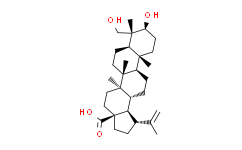| Cas No.: | 85999-40-2 |
| Chemical Name: | 23-Hydroxybetulinic acid |
| Synonyms: | ANEMOSAPOGININ;23-HYDROXYBETULINIC ACID;3β,23-Dihydroxylup-20(29)-en-28-oic acid;3beta,23-Dihydroxylup-20(29)-en-28-oic acid;(1R,3aS,5aR,5bR,7aR,9S,11aR,11bR,13aS,13bR)-9-hydroxy-8-(hydroxymethyl)-5a,5b,8,11a-tetramethyl-1-prop-1-en-2-yl-1,2,3,4,5,6,7,7a,9,10,11,11b,12,13,13a,13b-hexadecahydrocyclopenta[a]chrysene-3a-carbox;Anemosapogenin;A,23-Dihydroxylup-20(29)-en-28-oic acid;(3β,4α)-3,23-Dihydroxylup-20(29)-en-28-oic acid;3aH-Cyclopenta[a]chrysene, lup-20(29)-en-28-oic acid deriv.;(3As,5aR,5bR,7aS,8R,11aR,11bR,13aR,13bS)-9-hydroxy-8-(hydroxymethyl)-5a,5b,8,11a-tetramethyl-1-prop- |
| SMILES: | O([H])C1([H])C([H])([H])C([H])([H])[C@@]2(C([H])([H])[H])[C@@]([H])([C@]1(C([H])([H])[H])C([H])([H])O[H])C([H])([H])C([H])([H])[C@]1(C([H])([H])[H])[C@]2([H])C([H])([H])C([H])([H])[C@]2([H])[C@]3([H])C([H])(C(=C([H])[H])C([H])([H])[H])C([H])([H])C([H])([H])[C@]3(C(=O)O[H])C([H])([H])C([H])([H])[C@@]12C([H])([H])[H] |
| Formula: | C30H48O4 |
| M.Wt: | 472.6997 |
| Purity: | >98% |
| Sotrage: | 2 years -20°C Powder, 2 weeks 4°C in DMSO, 6 months -80°C in DMSO |
| Description: | 23-hydroxybetulinic acid is one of the bioactive components responsible for its anticancer activity. |
| In Vitro: | 23-hydroxybetulinic acid also shows different proliferation inhibitory activity against B16, HeLa, and HUVEC, with the IC50 value of 78.5, 80, and 94.8 uM, respectively. 23-hydroxybetulinic acid can promote cell cycle arrest at S phase and induce apoptosis via intrinsic pathway. 23-hydroxybetulinic acid disrupts mitochondrial membrane potential significantly (p<0.01) and selectively downregulates the levels of Bcl-2, survivin and upregulates Bax, cytochrome C, cleaved caspase-9 23-hydroxybetulinic acid can induce apoptosis in K562 cells. [1] 23-hydroxybetulinic acid enhances sensitivity of doxorubicin (DOX, ADR) on MCF-7/ADR cell lines, indicating its potential to be developed as a novel MDR modulator.[2] 23-HBA significantly improve the sensitivity of the tumor to doxorubicin. [3] |






















